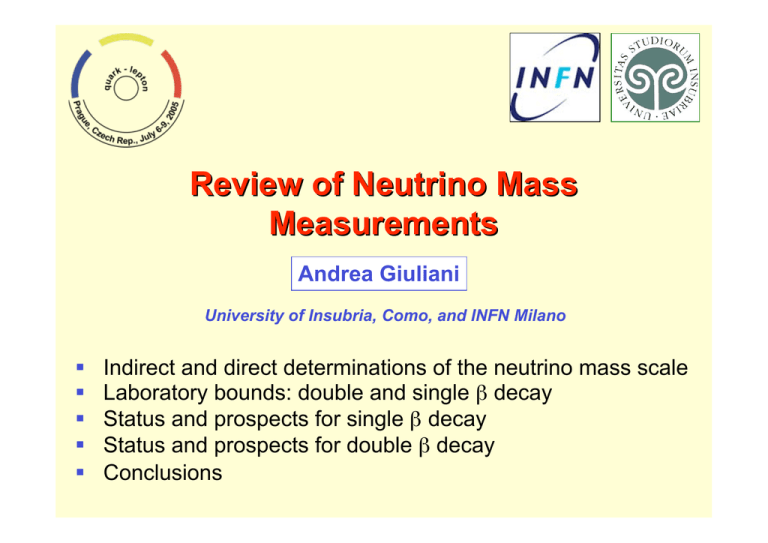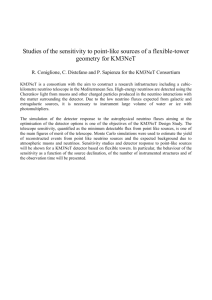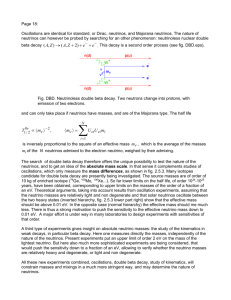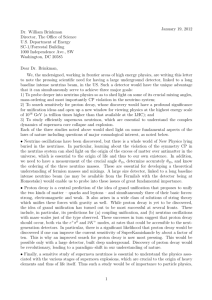Review of Neutrino Mass Measurements
advertisement

Review of Neutrino Mass Measurements Andrea Giuliani University of Insubria, Como, and INFN Milano Indirect and direct determinations of the neutrino mass scale Laboratory bounds: double and single β decay Status and prospects for single β decay Status and prospects for double β decay Conclusions Neutrino flavor oscillations and mass scale what we presently know from neutrino flavor oscillations oscillations do occur neutrinos are massive 2 given the three ν mass eigenvalues M1, M2, M3 we have approximate measurements of two ΔMij2 (ΔMij2 ≡ Mi2 – Mj2) ΔM122 ~ (9 meV)2 Solar |ΔM232| ~ (50 meV)2 Atmospheric approximate measurements and/or constraints on Ulj parametrized with three angles and three phases elements of the ν mixing matrix cij ≡ cosӨij sij ≡ sinӨij Neutrino flavor oscillations and mass scale The present knowledge can be summarized in this plot (Strumia-Vissani hep-ph/0503246) what we do not know from neutrino flavor oscillations: neutrino mass hierarchy absolute neutrino mass scale DIRAC or MAJORANA nature of neutrinos direct degeneracy ? inverted (M1~M2~M3 ) Tools for the investigation of the ν mass scale Present sensitivity Future sensitivity (a few year scale) 0.7 - 1 eV 0.1 eV Neutrinoless Double Beta Decay 0.5 eV 0.05 eV Single Beta Decay 2.2 eV 0.2 eV Tools Cosmology (CMB + LSS) Direct determination Model dependent Laboratory measurements Model dependent tools Neutrinoless Double Beta Decay it works only if neutrino is a Majorana particle ( ν ≡ νc ) uncertainties from nuclear physics other mechanisms (not only massive neutrinos) can mediate the process Cosmology (Cosmic Microwave Background + Large Scale Structure) very sensitive, but considerable spread in recently published results Aalseth et al, hep-ph/0412300 parameter degeneracy dependence on priors on cosmological parameters sensitivity to even small changes of input data necessity of direct measurement and cross checks at this scale Model independent tool: the kinematics of β decay basic idea: use only kinematics E2 = M2c4 + p2c2 processes involving neutrinos in the final state Single Beta Decay (A,Z) → (A,Z+1) + e- + νe dN dE Q = Mat(A,Z) – Mat(A,Z+1) ≅ Ee + Eν ∝ GF2 |Mif|2 (Ee+mec2) (Q – Ee)2 F(Z,Ee) S(Ee) [1 + δR(Z,Ee)] finite neutrino mass (Q – Ee)2 ⇒ electron kinetic energy distribution (Q – Ee) √ (Q – Ee)2 – Mν2c4 only a small spectral region very close to Q is affected Complementarity of cosmology, single and double β decay Cosmology, single and double β decay measure different combinations of the neutrino mass eigenvalues, constraining the neutrino mass scale In a standard three active neutrino scenario: Σ 3 ≡ Σ Mi i=1 3 cosmology simple sum pure kinematical effect 1/2 2 |U |2 Σ M 〈Mβ〉 ≡ i ei i=1 3 2 eiα | |Σ M |U | 〈Mββ〉 ≡ i ei i=1 i beta decay incoherent sum real neutrino double beta decay coherent sum virtual neutrino Majorana phases Present bounds 〈Mβ〉 [eV] The two bands merge in the degenerate case (the only one presently probed) Strumia-Vissani hep-ph/0503246 Two bands appear in each plot, corresponding to inverted and direct hierarchy 〈Mββ〉 [eV] Σ [eV] The three constrained parameters can be plot as a function of the lightest neutrino mass SINGLE BETA DECAY Effects of a finite neutrino mass on the beta decay The modified part of the beta spectrum is in a range of the order of [Q – Mνc2 , Q] Tritium as an example E – Q [eV] Effects of a finite neutrino mass on the Kurie plot The Kurie plot K(Ee) is a convenient linearization of the beta spectrum zero neutrino mass K(E) Q finite neutrino mass effect of: background energy resolution excited final states Q Q–Mνc2 Q ∫ (dN/dE) dE ≅ 2(δE/Q) Q-δE 3 Mass hierarchy In case of mass hierarchy: the Kurie plot ≡ superposition of three different sub - Kurie plots each sub - Kurie plot corresponds to one of the three different mass eigenvalues The weight of each sub – Kurie plot will be given by |Uej|2, where 3 |νe〉 = Σ Uei |νMi 〉 i=1 This detailed structure will not be resolved with present and planned experimental sensitivities (~ 0.2 eV) K(Ee) Q – M3 K(Ee) Q – M2 Q – M1 Ee Q Ee Mass degeneracy If the 3 mass components cannot be resolved or degeneracy holds: the Kurie-plot can be described in terms of a single mass parameter, a mean value of the three mass eigenstates K(Ee) 〈Mβ〉= Q – Mβ Q Ee Σ Mi2 |Uei|2 1/2 Two complementary experimental approaches 1 source separate from detector (the source is T - Q=18.6 keV) determine electron energy by means of a selection on the beta electrons operated by proper electric and magnetic fields measurement of the electron energy out of the source magnetic and electrostatic spectrometers present achieved sensitivity: ∼ 2 eV future planned sensitivity: ∼ 0.2 eV 2 source ≡ detector (calorimetric approach) (the source is 187Re - Q=2.5 keV) determine all the “visible” energy of the decay with a high resolution low energy “nuclear” detector measurement of the neutrino energy cryogenic microcalorimeters present achieved sensitivity: ∼ 10 eV future planned sensitivity: under study completely different systematic uncertainties Electrostatic spectrometers with Magnetic Adiabatic Collimation (MAC-E-filter) These instruments enabled a major step forward in sensitivity after 1993 They are the basic devices for next generation experiments aiming at the sub-eV range High magnetic field Bmax at source and detector. Low field Bmin at center. All electrons emitted in the forward hemisphere spiral from source to detector In the adiabatic limit Ek⊥ / B = constant Ek⊥(center) = Ek⊥(source) (Bmin/Bmax) Since Ee = Ek⊥ + Ek= constant efficient collimation effect in the center The retarding electric field at the center has maximum potential U0 and admits electrons with magnetic bottle Ek> eU0 Integral spectrometer Resolving power: ΔE / E = Bmin / Bmax ≅ 2 x 10-4 ΔE ≅ 4 eV at E ≅ 18 keV Experiments with MAC electrostatic spectrometers In the 90’s two experiments based on the same principle improved limit on neutrino mass down to about 2 eV at 95% c.l. Both experiments have reached their final sensitivity Troitsk (Russia) Mainz (Germany) gaseous T2 source unexplained anomaly close to the end point frozen T2 source complicated systematic in the source solved collaborations has joined + other institutions (large international collaboration) KATRIN KArlsruhe TRItium Neutrino experiment new generation experiment aiming at a further factor 10 improvement in sensitivity Mainz experiment: the results Clear improvement in signal-to-background ratio from 1994 set-up to 1998-2001 set-up To reduce systematic uncertainties, only the final 70 eV are used Similar results from Troitzk, but anomaly at the end-point (unknown peak of variable position and intensity) 〈Mβ〉 2 = - 0.6 ± 2.2 ± 2.1 eV2 〈Mβ〉 < 2.3 eV (95% c.l.) Final experimental sensitivity reached results obtained after a difficult struggle against subtle systematic effects Next generation of MAC spectrometer: the KATRIN proposal letter of intent - 2001 hep-ex/0109033 Goal: to reach sub-eV sensitivity on 〈Mβ〉 Strategy KATRIN design report Jan 2005 better energy resolution ⇒ ΔEFW ~ 1 eV higher statistic ⇒ stronger T2 source – longer measuring times better systematic control ⇒ in particular, improve background rejection Double source control of systematic Pre-spectrometer selects electrons with E>Q-100 eV (10-7 of the total) Main spectrometer high resolution ultra-high vacuum (p<10-11 mbar) high luminosity Better detectors: higher energy resolution time resolution (TOF) source imaging KATRIN sensitivity sensitivity 〈Mβ〉 < 0.2 eV (90%c.l.) discovery potential 〈Mβ〉 = 0.35 eV @ 5σ first tritium runs: mid 2009 The calorimetric approach to the measurement of the neutrino mass Calorimeters measure the entire spectrum at once use low Q beta decaying isotopes to achieve enough statistic close to Q best choice: 187Re – Q = 2.47 keV - 1 mg of natural Re ⇒ ~ 1 Bq event frac. in the last 10 eV: 1.3x10-7 Advantages of calorimetry no backscattering no energy loss in the source no excited final state problem no solid state excitation vs. 3x10-10 for T beta spectrum Drawbacks of calorimetry systematic induced by pile-up effects energy dependent background (dN/dE)exp=[(dN/dE)theo+ Aτr(dN/dE)theo⊗ (dN/dE)theo] ⊗ R(E) generates “background” at the end-point Bolometric detectors of particles: basic concepts Energy absorber crystal containing Re M ~ 0.25 mg basic parameter: C Thermometer Si-implanted thermistor basic parameters: R ≅ 1.5 MΩ Τ ≅ 100 mK dR/dT ≅ 50 kΩ/mK Heat sink T ~ 80 mK dilution refrigerator Thermal coupling read-out wires in the future, µ−machined legs basic parameter: G G ≅ 0.02 pW / mK Variable Range Hopping conduction regime exponential increase of R with decreasing T Temperature signal: ΔT = E/C ≅ 1 mK for E = 2.5 keV Bias: I ≅ 0.5 nA ⇒ Joule power ≅ 0.4 pW ⇒Temperature rise ≅ 20 mK Voltage signal: ΔV = I × dR/dT × ΔT ⇒ ΔV ≅ 30 µV for E = 2.5 keV Signal recovery time: τ = C/G ≅ 20 ms Noise over signal bandwidth (≅ 1 kHz): Vrms = 0.2 µV Energy resolution ≅ 10 eV MIBETA (Milano/Como) experiment: the detectors Energy absorbers Thermistors Si-implanted thermistors AgReO4 single crystals high sensitivity 187Re activity ≅ 0.54 Hz/mg M ≅ 0.25 mg ⇒ A ≅ 0.13 mHz many parameters to play with high reproducibility ⇒ array possibility of µ-machining typically, array of 10 detectors lower pile up & higher statistics ~ 1 mm K(E) MIBETA experiment: the Kurie - plot total Kurie – plot 5 x 106 187Re decays above 700 eV E (keV) MIBETA experiment: the neutrino mass Fit parameters single gaussian: ΔEFWHM = 27.8 eV fitting interval: 0.8 – 3.5 keV free constant background: 6 x 10-3 c/keV/h free pile-up fraction: 1.7 x 10-4 〈Mβ〉 2 = -141 ± 211 stat ± 90 sys eV2 (preliminary) 〈Mβ〉 < 15.6 eV (90% c.l.) similar results obtained by the MANU experiment (Genoa) The future of bolometric experiments proposal in preparation for an expansion of the Re experiment The future of bolometric experiments: MARE General strategy: push up bolometric technology in order to: multiplicate number of channels improve energy resolution decrease rise-time simulations I phase goal: reach 2 eV sensitivity The future in bolometric experiments: MARE simulations II phase goal: reach 0.2 eV sensitivity ΔE(eV), τR(µs), A(Hz) 50000 channels in 5 y DOUBLE BETA DECAY Decay modes for Double Beta Decay Two decay modes are usually discussed: 2ν Double Beta Decay allowed by the Standard Model already observed – τ ≥ 1019 y (A,Z) → (A,Z+2) + 2e- + 2νe (A,Z) → (A,Z+2) + 2e- neutrinoless Double Beta Decay (0ν-DBD) never observed (except a discussed claim) τ > 1025 y Processe would imply new physics beyond the Standard Model violation of lepton number conservation It is a very sensitive test to new physics since the phase space term is much larger for the neutrinoless process than for the standard one interest for 0ν-DBD lasts for 65 years ! Goeppert-Meyer proposed the standard process in 1935 Racah proposed the neutrinoless process in 1937 Neutrino properties and 0ν-DBD u d WW- d u eνe νe a LH neutrino (L=-1) is absorbed at this vertex a RH antineutrino (L=1) is emitted at this vertex in pre-oscillations standard particle physics (massless neutrinos), the process is forbidden because neutrino has not the correct helicity / lepton number to be absorbed at the second vertex e- IF neutrinos are massive DIRAC particles: Helicities can be accommodated thanks to the finite mass, BUT Lepton number is rigorously conserved IF neutrinos are massive MAJORANA particles: Helicities can be accommodated thanks to the finite mass, AND Lepton number is not relevant Observation of 0ν-DBD mν ≠ 0 ν≡ν 0ν-DBD is forbidden 0ν-DBD is allowed 0ν-DBD and neutrino flavor oscillations how 0ν-DBD is connected to neutrino mixing matrix and masses neutrinoless Double Beta Decay rate Phase space Nuclear matrix elements Effective Majorana mass 1/τ = G(Q,Z) |Mnucl|2〈Mββ〉 2 〈Mββ〉 = ||Ue1 | 2M1 + eiα | Ue2 | 2M2 + eiα |Ue3 | 2M3 | 1 2 can be of the order of ~ 50 meV in case of inverted hierarchy The problem of nuclear matrix elements Large systematics introduced by nuclear physics in the calculation of |Mnucl|2 lifetimes foreseen by different nuclear models for 〈Mββ〉 = 50 meV Unit: 1026 year ⇒ in the best cases, nuclide 1 decay / year / 100 moles ! nuclear models 76Ge 6.8 70.8 56.0 9.3 12.8 14.4 130Te 0.6 23.2 2.8 2.0 3.6 3.4 4.0 5.1 1.2 15.6 0.1 0.2 100Mo 150Nd Electron sum energy spectra in DBD The shape of the two electron sum energy spectrum enables to distinguish among the three different discussed decay modes two neutrino DBD continuum with maximum at ~1/3 Q neutrinoless DBD peak enlarged only by the detector energy resolution sum electron energy / Q Experimental approaches to direct searches Two approaches for the detection of the two electrons: e- e- Source ≡ Detector (calorimetric technique) scintillation cryogenic macrocalorimeters (bolometers) solid-state devices gaseous detectors high energy resolution e- detector source e- detector Source ≠ Detector scintillation gaseous TPC gaseous drift chamber magnetic field and TOF event reconstruction Experimental sensitivity to 0ν-DBD sensitivity F: lifetime corresponding to the minimum detectable number of events over background at a given (1 σ) confidence level live time energy resolution source mass F ∝ MT F ∝ (MT / bΔE)1/2 background level b≠0 b: specific background coefficient [counts/(keV kg y)] b=0 importance of the nuclide choice (but large uncertainty due to nuclear physics) sensitivity to 〈Mββ〉 ∝ (F/Q |Mnucl |2)1/2 ∝ Q1/2 1 |Mnucl| bΔE MT 1/4 Present experimental situation in the search for 0νDBD I will give some details about three presently most sensitive experiments: Heidelberg – Moscow (HM) (Gran Sasso) the most sensitive DBD experiment since 10 years (stopped in May 03) NEMO3 (Modane) it is an intermediate generation experiment capable to study different candidate nuclides and to improve the HM results (running) CUORICINO (Gran Sasso) it is an intermediate generation experiment with the potential to improve the HM result (running) it is also a prelude to a new generation experiment, CUORE (Cryogenic Underground Observatory for Rare Events), The Heidelberg Moscow experiment Source = detector Well established technology of Ge diodes This technique has been dominating the field for decades and is still one of the most promising for the future E. Fiorini – 60s Five Ge diodes for an overall mass of 10.9 kg isotopically enriched ( 86%) in 76Ge Underground operation in the Gran Sasso laboratory (Italy) Lead box and nitrogen flushing of the detectors Digital Pulse Shape Analysis (PSA) (factor 5 reduction) 7.6 × 1025 76Ge nuclei identification of Multi-site events (gamma background) Background in the region of DBD: b = 0.17 counts/(keV kg y) 〈Mββ〉 < 0.3 – 2.5 eV similar results obtained by IGEX experiment HM: claim of evidence of 0ν-DBD Suddenly, in December 2001, 4 authors (KDHK) of the HM collaboration announce the discovery of neutrinoless DBD most probable value of events: 14.8 in 46 kg y exposure KDHK claim: mee = 0.11 - 0.56 eV (0.39 eV b.v.) τ1/20ν (y) = (0.8 – 18.3) × 1025 y (1 × 1025 y b.v.) (95 % c.l.) H.V. Klapdor-Kleingrothaus et al. Mod. Phys. Lett. A 16 (2001) 2409 later, the authors widen the allowed range for mee to account for nuclear matrix element uncertainty: 〈Mββ〉 = 0.05 - 0.84 eV (95% c.l.) immediate skepticism in DBD community Aalseth CE et al. , Mod. Phys. Lett. A 17 (2002) 1475 Feruglio F et al. , Nucl. Phys. B 637 (2002) 345 Zdezenko Yu G et al., Phys. Lett. B546(2002)206 Klapdor-Kleingrothaus HV hep-ph/0205228 H.L. Harney, hep-ph/0205293 Comments and reanalysis of HD-M data Independent replies to the Comments Recent new papers about claim of evidence With respect to the 2001 results, now data with higher statistics and with better quality show an increase of the statistical significance of the “peak”: 2001 54.98 kg•y 2004 2.2 σ 71.7 kg•y 4.2 σ Recent new papers about claim of evidence Many background features are still to explain Looking at a larger range, many structures resemble the DBD “peak” and need to be explained The statistical significance depends on the flat component of the background Strumia-Vissani hep-ph/0503246 NEMO3 Source ≠ detector Well established technologies in particle detection: tracking volume with Geiger cells plastic scintillators magnetic field The most sophisticated DBD detector with external source Different sources in form of foil can be used simultaneously Underground operation in the Frejus laboratory (France) Water and iron shields 4.1 × 1025 100Mo nuclei other sources 1 SOURCE 2 TRACKING VOLUME 3 CALORIMETER detector scheme NEMO3 Beautiful results on 100Mo and on other nuclides 2ν spectrum a DBD event τ1/22ν (y) = 7.8 ± 0.09 stat ± 0.8 syst × 1018 y τ1/20ν (y) > 3.5 × 1023 y 〈Mββ〉 < 0.7 – 1.2 eV final sensitivity: 0.2 – 0.35 eV intrinsic limits: source strength low energy resolution ⇒ 2ν background CUORICINO Source = detector Bolometric technique: young (born in ~ 1985) but now firmly established Nuclide under study: 130Te CUORICINO source The bolometric technique for the study of DBD was proposed by E. Fiorini and T.O. Niinikoski in 1983 0ν DBD is a factor 5-10 faster than in 76Ge A.I.: 34% ⇒ enrichment not necessary experiments can be expanded at low cost 5.2 × 1025 130Te nuclei Bolometric technique: the nuclear energy is measured as a temperature increase of a single crystal ΔT = E/C thanks to a proper thermometer, ΔT ⇒ ΔV In order to get low specific heat, the temperature must be very low (5 – 10 mK) Typical signal sizes: 0.1 mK / MeV, converted to about 1 mV / MeV The CUORICINO set-up CUORICINO = tower of 13 modules, 11 modules x 4 detector (790 g) each 2 modules x 9 detector (340 g) each M = ~ 41 kg Coldest point Underground operation in the Gran Sasso laboratory (Italy) Cold finger Tower Lead shield Same cryostat and similar structure as previous pilot experiment CUORICINO modules thermometer (doped Ge chip) single TeO2 crystal 790 g 5 x 5 x 5 cm CUORICINO results and sensitivity Anticoincidence background spectrum 5.0 kg y Background level 0.18 ±0.02 c/keV/kg/y Powerful test of KDHK τ1/20ν (y) > 1.8 × 1024 y 〈Mββ〉 < 0.2 – 1.1 eV (90% c.l.) 3 y sensitivity (with present performance): 1 × 1025 y 〈Mββ〉 < 0.13 – 0.31 eV The future: a great number of proposed experiments COBRA 130Te 10 kg CdTe semiconductors DCBA 150Nd 20 kg Nd layers between tracking chambers CAMEO 114Cd 1 t CdWO4 crystals CANDLES 48Ca Several tons CaF2 crystals in liquid scint. CUORE 130Te 750 kg TeO2 bolometers EXO 136Xe 1 ton Xe TPC (gas or liquid) GEM 76Ge 1 ton Ge diodes in liquid nitrogen GENIUS LNGS-LoI 35/04 76Ge 76Ge 1 ton Ge diodes in liquid nitrogen 1 ton Ge diodes in liquid nitrogen/argon GSO 160Gd 2 t Gd2SiO5:Ce crystal scint. in liquid scint. Majorana 76Ge 500 kg Ge diodes MOON 100Mo Mo sheets between plastic scint., or liq. scint. Xe 136Xe 1.56 t of Xe in liq. Scint. XMASS 136Xe 10 t of liquid Xe Potential large-mass (~1 ton) future experiments More promising projects (attack the 50 meV mass scale): GERDA SUPERNEMO CUORE EXO MAJORANA Europe In Europe, joint effort on common problems Europe + US US IDEA project – Integrated Double-beta-decay European Activities funded by the European Commission inside a large astroparticle physics program GERDA New 76Ge experiment. Basic points: Collect all the existing 76Ge material (HM+IGEX) ⇒ ~20 kg (+ 30 kg new) (collaboration with Kurchatov) Operate it in liquid nitrogen, which acts as a coolant and as a passive shielding ( + traditional shielding) Replace possibly liquid nitrogen with scintillating liquid argon (active shield) Acquire the 20 kg enriched material in a 0 background set-up powerful intermediate experiment test KDHK evidence with the same nuclides (lifetime sensitivity: 3 x 1025 y) Procurement of further enriched material ⇒ final ~ 1 ton experiment 〈Mββ〉 < 20 - 50 meV GERDA: Baseline design Clean room lock Water tank / buffer/ muon veto Vacuum insulated copper vessel Liquid N/Ar Ge Array From CUORICINO to CUORE (Cryogenic Underground Observatory for Rare Events) CUORE = closely packed array of 988 detectors 19 towers - 13 modules/tower - 4 detectors/module M ~ 750 kg Compact structure, ideal for active shielding Each tower is a CUORICINO-like detector Special dilution refrigerator CUORE background and sensitivity Montecarlo simulations of the background show that b = 0.001 counts / (keV kg y) is possible with the present bulk contamination of detector materials The problem is the surface background (alpha, beta energy-degraded) it must be reduced by a factor 10 – 100 work in progress! 5 y sensitivity with pessimistic background: 5 y sensitivity with optimistic background: b = 0.01 counts/(keV kg y) b = 0.001 counts/(keV kg y) F0ν = 9.4 × 1025 × ( T [ y ] )1/2 F0ν = 2.9 × 1026 × ( T [ y ] )1/2 〈Mββ 〉< 20 – 100 meV enriched CUORE 〈Mββ 〉 < 10 – 50 meV 〈Mββ 〉 < 7 – 38 meV Conclusions Σ [eV] Exciting times for neutrino masses: degeneracy will be deeply probed PLANCK + larger surveys β KDHK claim 〈Mββ〉 [eV] 〈Mβ〉 [eV] KATRIN, MARE S I N G L E Strumia-Vissani hep-ph/0503246 discovery potential in case of inverted hierarchy (HM,CUORICINO, NEMO) CUORE, GERDA, etc. C O S M O L O G Y D O U B L E β




